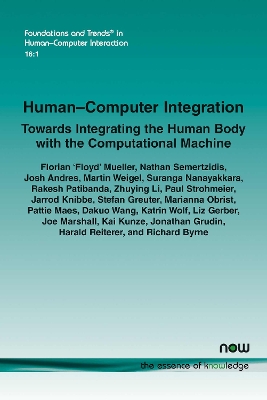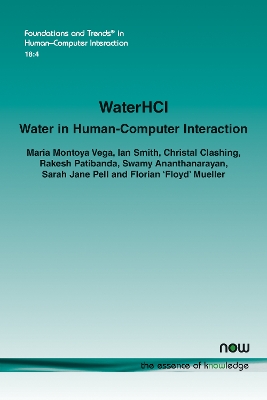Foundations and Trends® in Human-Computer Interaction
2 total works
Human-Computer Integration
by Florian ‘Floyd’ Mueller, Nathan Semertzidis, Josh Andres, Martin Weigel, Suranga Nanayakkara, Rakesh Patibanda, Zhuying Li, Paul Strohmeier, Jarrod Knibbe, Stefan Greuter, Marianna Obrist, Pattie Maes, Dakuo Wang, Katrin Wolf, Liz Gerber, Joe Marshall, Kai Kunze, Jonathan Grudin, Harald Reiterer, and Richard Byrne
Published 6 October 2022
Human-Computer Integration (HInt) is an emerging paradigm in the human-computer interaction (HCI) field. Its goal is to integrate the human body and the computational machine. Because HInt is not an isolated area of research, the authors draw upon discussions from related perspectives, including cybernetics, augmentation, cyborgs, and wearables. While these prior works provide a basis for HInt, and some of their associated challenges also apply to HInt, the authors focus on articulating the HInt challenges that are of particular relevance to HCI.
The monograph makes three contributions: First, the authors apply two key dimensions from psychology – bodily agency and bodily ownership – to enhance our understanding of HInt systems. Second, they use these two dimensions to provide new perspectives on user integration experiences and to develop an integration systems design space. Third, they use the design space and its two dimensions to articulate HInt’s key challenges and group these challenges into four areas: design, society, identity, and technology. Ultimately, the work aims to facilitate a more structured investigation into human body and computational machine integration.
The monograph makes three contributions: First, the authors apply two key dimensions from psychology – bodily agency and bodily ownership – to enhance our understanding of HInt systems. Second, they use these two dimensions to provide new perspectives on user integration experiences and to develop an integration systems design space. Third, they use the design space and its two dimensions to articulate HInt’s key challenges and group these challenges into four areas: design, society, identity, and technology. Ultimately, the work aims to facilitate a more structured investigation into human body and computational machine integration.
WaterHCI
by Maria Montoya Vega, Ian Smith, Christal Clashing, Rakesh Patibanda, Swamy Ananthanarayan, Sarah Jane Pell, and Florian ‘Floyd’ Mueller
Published 11 December 2024

